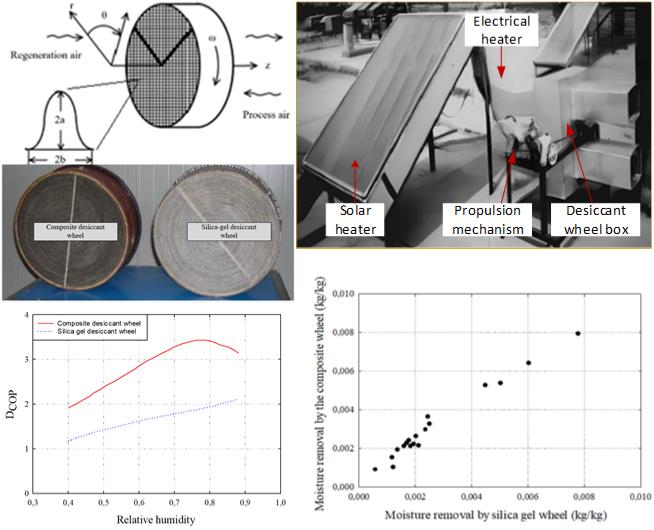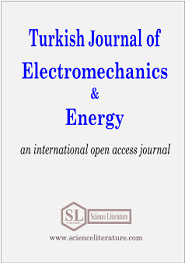
Rotary desiccant wheel systems: A review
Abstract
Rotary desiccant wheel (RDW) systems work in line with the dehumidification principle. These systems use salt, such as silica gel (SG) for dehumidifying the process air (PA). Desiccant cooling is adopted as an alternative option against traditional cooling systems owing to its outstanding advantages. Regeneration is of vital importance in the overall performance assessment of RDW systems. In terms of regeneration technique, these systems can be split into two types, which are natural and electrical regeneration. Natural regeneration systems usually have solar air collectors. On the other hand, electrical regeneration systems use typical fossil fuel-powered heaters. Many design-oriented factors influence the performance of RDW systems. At the same time, operating conditions have a notable influence on system performance. The objective of this article is to furnish insights into recent research concerning RDW systems, as well as to highlight cost-effective and environmentally friendly approaches aimed at improving the performance characteristics of these systems. Coefficient of performance (COP), cost, payback period, dehumidification effectiveness, and moisture reduction rate are taken into consideration in the comparative performance assessment analyses.
Full Text:
PDFReferences
B. S. Davanagere, S. A. Sherif, & D. Y. Goswami, “A feasibility study of a solar desiccant air‐conditioning system—Part I: psychrometrics and analysis of the conditioned zone,” International Journal of Energy Research, 23(1), pp. 7-21, 1999.
E. M. Sterling, A. Arundel, & T. D. Sterling, “Criteria for human exposure to humidity in occupied buildings,” ASHRAE Trans., 91(1), pp. 611-622, 1985.
S. Tian, X. Su, & Y. Geng, “Review on heat pump coupled desiccant wheel dehumidification and air conditioning systems in buildings,” Journal of Building Engineering, vol. 54, pp. 104655, August 2022.
Y. E. Güzelel, U. Olmuş, K. N. Çerçi, O. Büyükalaca, “New multiple regression and machine learning models of rotary desiccant wheel for unbalanced flow conditions,” International Communications in Heat and Mass Transfer, vol. 134, pp. 106006, May 2022.
H. Y. Tsai, and C. T. Wu, “Optimization of a rotary desiccant wheel for enthalpy recovery of air-conditioning in a humid hospitality environment,” Heliyon, 8(10), 2022.
T. S. Ge, Y. Li, R. Z. Wang, & Y. J. Dai, “A review of the mathematical models for predicting rotary desiccant wheel,” Renewable and Sustainable Energy Reviews, 12(6), pp. 1485-1528, 2008.
C. E. L. Nóbrega, and N. C. L. Brum, An introduction to solid desiccant cooling technology. In Desiccant-Assisted Cooling: Fundamentals and Applications, November 2013, pp. 1-23.
K. Daou, R. Z. Wang, & Z. Z. Xia, “Desiccant cooling air conditioning: a review,” Renewable and Sustainable Energy Reviews, 10(2), pp. 55-77, 2006.
G. Panaras, E. Mathioulakis, & V. Belessiotis, “Solid desiccant air-conditioning systems–Design parameters,” Energy, 36(5), pp. 2399-2406, 2011.
X. Zheng, T. S. Ge, and R. Z. Wang, “Recent progress on desiccant materials for solid desiccant cooling systems,” Energy, vol. 74, pp. 280-294, September 2014.
L. Yadav, A. K. Verma, V. Dabra, and A. Yadav, “Performance Comparison of Different Desiccant Material Based Wheels for Air Conditioning Application,” pp. 912-923, August 2023.
G. Angrisani, C. Roselli, and M. Sasso, “Distributed microtrigeneration systems,” Progress in Energy and Combustion Science, 38(4), pp. 502-521, 2012.
G. Angrisani, C. Roselli, and M. Sasso, “Effect of rotational speed on the performances of a desiccant wheel,” Applied Energy, vol. 104, pp. 268-275, April 2013.
Y. M. Harshe, R. P. Utikar, V. V. Ranade, and D. Pahwa, “Modeling of Rotary Desiccant Wheels,” Chem. Eng. Technol., vol. 28, pp. 1473-1479, November 2005.
S. Yamaguchi, and K. Saito, “Numerical and experimental performance analysis of rotary desiccant wheels,” International Journal of Heat and Mass Transfer, vol. 60, pp.51-60, May 2013.
G. Panaras, E. Mathioulakis, V. Belessiotis, and N. Kyriakis, “Experimental validation of a simplified approach for a desiccant wheel model,” Energy and Buildings, vol. 42, pp. 1719-1725, October 2010.
J. J. Jurinak, “Open cycle solid desiccant cooling--component models and system simulations,” Ph.D. dissertation, The University of Wisconsin-Madison, 1982.
T. S. Ge, Y. Li, R. Z. Wang, and Y. J. Dai, “Experimental study on a two-stage rotary desiccant cooling system,” International Journal of Refrigeration, 32(3), pp. 498-508, 2009.
T. S. Ge, Y. J. Dai, R. Z. Wang, and Y. Li, “Experimental investigation on a one-rotor two-stage rotary desiccant cooling system,” Energy, vol. 33, pp. 1807-1815, December 2008.
Z. Ma, X. Liu, and T. Zhang, “Experimental investigation and effectiveness analysis of a desiccant wheel dehumidification system with low air humidity,” Applied Thermal Engineering, vol. 226, pp. 120279, May 2023.
U. Hanifah & M. A. Karim & A. Haryanto & R. Alfiyah & A. Taufan, “Experimental performance of A rotary desiccant wheel without honeycomb matrix structure: a preliminary study,” In IOP Conference Series: Materials Science and Engineering, vol. 1096, pp. 012043, March 2021.
L. Yadav, and A. Yadav, “Effect of different arrangements of sector on the performance of desiccant wheel,” Heat and mass transfer, vol. 54, pp. 7-23, July 2018.
D. O’Connor, J. K. Calautit, and B. R. Hughes, “A novel design of a desiccant rotary wheel for passive ventilation applications,” Applied Energy, vol. 179, pp. 99-109, October 2016.
C. X. Jia, Y. J. Dai, J. Y. Wu, and R. Z. Wang, "Use of compound desiccant to develop the high-performance desiccant cooling system," International Journal of Refrigeration, 30(2), pp. 345-353, March 2007.
X. J. Zhang, K. Sumathy, Y. J. Dai, and R. Z. Wang, "Dynamic hygroscopic effect of the composite material used in a desiccant rotary wheel," Solar Energy, vol. 80, pp. 1058-1061, August 2006.
M. Su, X. Han, D. Chong, J. Wang, J. Liu, & J. Yan, “Experimental study on the performance of an improved dehumidification system integrated with precooling and recirculated regenerative rotary desiccant wheel,” Applied Thermal Engineering, vol. 199, pp. 117608, November 2021.
G. Angrisani, C. Roselli, and M. Sasso, “Effect of rotational speed on the performances of a desiccant wheel,” Applied Energy, vol. 104, pp. 268-275, April 2013.
L. Chen, S. H. Chen, L. Liu, and B. Zhang, “Experimental investigation of precooling desiccant-wheel air-conditioning system in a high-temperature and high-humidity environment,” International Journal of Refrigeration, vol. 95, pp. 83-92, November 2018.
M. Gadalla, and M. Saghafifar, “Performance assessment and transient optimization of air precooling in multi-stage solid desiccant air conditioning systems,” Energy Conversion and Management, vol. 119, pp. 187-202, July 2016.
M. H. Ahmed, N. M. Kattab, and M. Fouad, “Evaluation and optimization of solar desiccant wheel performance,” Renewable Energy, vol. 30, pp. 305-325, March 2005.
Y. Liu, Y. Chen, D. Wang, J. Liu, L. Li, X. Luo, Y. Wang, and J. Liu, “Performance evaluation of a hybrid solar powered rotary desiccant wheel air conditioning system for low latitude isolated islands,” Energy and Buildings, vol. 224, pp. 110208, October 2020.
A. E. Kabeel, and M. Abdelgaied, “Performance of novel solar dryer,” Process Safety and Environmental Protection, vol. 102, pp. 83-189, July 2016.
URN: https://sloi.org/urn:sl:tjoee82294
Copyright (c) 2023 Turkish Journal of Electromechanics and Energy

This work is licensed under a Creative Commons Attribution-NonCommercial 4.0 International License.

 Indexed in:
Indexed in:
















